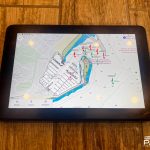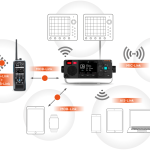USCG warns about LED lights interfering with VHF & AIS, wants test results
The USCG recently issued a Safety Alert about how LED lighting near VHF antennas can cause poor reception on attached radios, which of course includes AIS and DSC reception along with regular marine VHF audio channels. I’m surprised because I remember such problems coming up and being solved a decade ago, which was very early in the evolution of LED lighting.
For instance, when I wrote “LED nav lights, a fast moving target” in 2008, it quickly got comments about various interference issues and especially in regard to the popular Orca Green Marine tricolors (often installed right next to a masthead VHF antenna). But then OGM redesigned the nav light circuitry (their 2010 tech blog post still up) and today offers a full line of LED nav lights I’ve never heard a complaint about.
But then again, some early complaints about badly designed or manufactured LED fixtures — or especially replacement bulbs — involved interference you could actually hear as noise on a VHF radio, and what the USCG is warning about is a more insidious silent interference whereby you simply don’t hear the real signals that should be reaching your radio (or chart plotter as AIS targets). They have devised a way to test for this on your boat, however, and they are also asking mariners to report any LED lighting products that seem to cause trouble.
So I’ve published the entire Safety Alert below, and it can also be downloaded from the USCG Safety Alert \ Lessons Learned page. Plus I tried the contact page where you can report issues, and it’s easy (as seen on the screen at bottom). I’m hoping that any readers who do detect problems report them here too, though I’m also hoping that most all modern marine LED lighting fixtures do not create any interference issues.
************************************************************
Let us enlighten you about LED lighting!
Potential interference of VHF-FM Radio and AIS Reception.
The U.S. Coast Guard has received reports from crews, ship owners, inspectors and other mariners regarding poor reception on VHF frequencies used for radiotelephone, digital selective calling (DSC) and automatic identification systems (AIS) when in the vicinity of light emitting diode (LED) lighting on-board ships (e.g., navigation lights, searchlights and floodlights, interior and exterior lights, adornment).
Radio frequency interference caused by these LED lamps were found to create potential safety hazards. For example, the maritime rescue coordination center
in one port was unable to contact a ship involved in a traffic separation scheme incident by VHF radio. That ship also experienced very poor AIS reception. Other
ships in different ports have experienced degradation of the VHF receivers, including AIS, caused by their LED navigation lights. LED lighting installed near VHF antennas has also shown to compound the reception.
Strong radio interference from LED sources may not be immediately evident to maritime radio users. Nonetheless, it may be possible to test for the presence of LED interference by using the following procedures:
1. Turn off LED light(s).
2. Tune the VHF radio to a quiet channel (e.g. Ch. 13).
3. Adjust the VHF radio’s squelch control until the radio outputs audio noise.
4. Re-adjust the VHF radio’s squelch control until the audio noise is quiet, only slightly above the noise threshold.
5. Turn on the LED light(s). If the radio now outputs audio noise, then the LED lights have raised the noise floor. (Noise floor is generally the amount of interfering signals / static received beyond the specific signal or channel being monitored.)
6. If the radio does not output audio noise, then the LED lights have not raised the noise floor.
If the noise floor is found to have been raised, then it is likely that both shipboard VHF marine radio and AIS reception are being degraded by LED lighting.
In order to determine the full impact of this interference, the Coast Guard requests those experiencing this problem to report their experiences to Coast Guard Navigation Center. Select “Maritime Telecommunications” on the subject drop down list, then briefly describe the make and model of LED lighting and radios effected, distance from lighting to antennas and radios effected, and any other information that may help understand the scope of the problem.
This Safety Alert is provided for informational purposes only and does not relieve any domestic or international safety, operational, or material requirement. Developed by the U.S. Coast Guard, Spectrum Management and Telecommunications Policy Division. Distributed by the Office of Investigations and Analysis. Questions may be sent to [email protected].
************************************************************















While its nice to see the USCG interested in the subject, their proposed test is pretty meaningless. FM radio receivers operate their squelch control by measuring the amount of high-frequency noise (above the frequencies used for voice – typically 5-7 kHz) they are detecting – with no signal, the noise level is maximum, while a signal entering the receiver reduces or “quiets” the amount of noise – hence the phrase “a full-quieting signal”. Their test looks for a signal on the VHF channel, not noise, which is indeed a more subtle and insidious problem.
IMHO, if you are concerned about noise being radiated by LED fixtures, a better test is to tune in a weak but steady signal – a distant NOAA WX station works well – then turn on your suspect lights. If the light is radiating noise, the signal will audibly degrade or even disappear into the noise.
FWIW, we haven’t seen any problems with our LEDs bought in the last 3-4 years from Marinebeam, though we did have some LEDs from a decade ago that needed their own radio license!
I have a Signal Mate LED a few inches from my VHF antenna on the top of the mast as well as Marinebeam LED’s throughout the boat and never experienced any interference at all on VHF. I even heard VTS call me when approaching NY Harbor this summer. All my LED’s are second generation purchased about four or five years ago.
I have seen this problem most recently with a 43ft sailboat I re-wired. The method described in the press release is more than adequate to the task. If you’d like to refine your search for the offending LED remove the antenna from a handheld and walk around with it, with the squelch all the way down…. noise blaring. You will notice some subtle changes in the character in the noise and it will peak and fade as you pass by the offending device.
This will probably be a cheap LED assembly with some type of voltage step down circuit. Lower power LEDs just put a resistor in series with the diode (LED) and burned a bit of power as heat in the resistor. As lumens increased it became difficult to dissipate heat internally from the power wasted in the resistor. So much of the industry has shifted to some type of step down voltage circuitry. Unfortunately, the amateurs in this LED lighting industry fail to realize the potential for radio frequency interference being generated within their products. But that is ok, ’cause the FCC does. If you have something as simple as an RC oscillator or any other type of synchronous circuit in a consumer or industrial product it falls under the gigantic umbrella of FCC Part 15 just like a radio, tv or computer. There are more than a few sources of cheap LED lighting products coming on shore which are not properly FCC Part 15 test and/or certified…. After all it is just a light bulb, right? Wrong. If the guy in the boat next to you finds your boat emitting RF noise he has every right to demand it be fixed even if it doesn’t seem to bother any of your electronics.
RF Noise is generated by electrical switching circuity. Digital wave-forms are square-wave in nature with very high rise times. Digital wave-forms generate RF noise. These digital wave-forms can be generated from LEDS, switching power supplies in inverters, etc. The RF noise generated by these devices can appear within the VHF band. This unwanted RF noise will raise the noise floor within the VHF band and degrade the radio’s signal to noise ratio. Its like being in a room where everyone is talking loudly. You can’t hear the softer voices. Using the squelch method can show that the noise floor has been raised because the unwanted noise will break the squelch threshold. A better way is to tune to a weak signal and turn the light on and off as already mentioned. Shakespeare makes an antenna tester that generates an RF VHF signal to test the receiver that may work for this application. A radio shop can get more exacting measurements by measuring the SINAD or sensitivity of the receiver when the LED light is turned on and off but this takes commercial test equipment capable of measuring 12 dB SINAD or 20 dB quieting.
An addition to the previous post. The RF noise can get into the radio by conduction through a wire or by radiation though the air. Testing methods using SINAD and quieting will work for conducted noise. Radiated noise can be measured by averaging the noise level across the speaker terminals (AC voltage) with the squelch open (on a quiet channel) and then noting any changes when the LED light is turned on and off. This test method will quantify how much the noise floor is raised.
I cannot offer any report of an LED lamp causing interference to my VHF Marine Band radio receiver’s useful sensitivity, but I did find that a Part-15 home-type DVD player caused significant reduction in reception when simply powered on. The DVD player is a device that is supposed to comply with Part-15 radio emission, as far s I know, yet it caused a rather noticeable increase in radio-frequency noise in the VHF Marine Band.
My testing method, as mentioned above, was using weak signals received from distant NOAA weather broadcast stations as the signal source. With the DVD player powered off, there signals from stations as far as 100-miles away were received. With the DVD player powered on, those signals disappeared into the noise floor.
THank you for promptly posting and promoting responses to this USCG warning. RFI issues affecting radio performance is rampant with our digital age. LED lights are only one common culprit. Florescent lighting is worse and your laptop may also be causing serious interference.
Although I retired from the Coast Guard 5 yrs ago I’ve been working closely with them regarding this issue. Thanks to the many who have responded. We’ve learned a lot.
For example, we’ve learned that the problem is more severe than we initially realized. While some responses indicated no problem for them, several others confirmed that the problem has indeed affected them. We also learned that LED navigation lights certified to the IMO-recognized shipboard EMC standard IEC 60553/60945 is no guarantee they won’t interfere with VHF radio or AIS. IEC 60533 includes the statement “The radiated emission requirements within the range of receiving frequencies presume in the bridge and deck zone a minimum distance of 3 m between the emitters and the receiving antennas”. In other words, compliant LED navigation lighting should be separated at least 3m from antennas, especially VHF antennas.
As Judy mentioned, RFI from devices such as fluorescent lighting and laptops is also a long standing problem. What’s new here however is best described by the FCC in a Notice they released in 2016: “..we have found that emissions from RF LED lighting devices are non-periodic, broadband in nature, and are produced as a byproduct of the internal driver circuitry within the RF LED lighting device. These types of broadband, non-periodic emissions have adequate energy and potential to generate radiated emissions well above 30 MHz.”. See https://apps.fcc.gov/kdb/GetAttachment.html?id=K0pZdRE7biF3aqgO4XZ8cw%3D%3D&desc=640677%20D01%20RF%20LED%20LIGHTING%20v01&tracking_number=20518.
Finally, the test procedure described in the Safety Notice was never intended to detect an interfering signal, but instead to determine if the RF noise floor was being raised as a result of the LED operation. Nevertheless if your radio is capable of receiving NOAA Weather Radio, tuning to a weak station as instructed above is an excellent means for detecting interference. Thank you for suggesting it.
I have an OGM mast head tricolor / anchor / strobe (LXTA-SP) that I purchased in Aug 2009. This is after I read OGM’s June 2009 tech blog article that provided assurances that VHF interference issues had been resolve:
https://ogmtechnical.blogspot.com/2009/06/update-on-rf-interference-for-trianchor.html
My unit is unsafe. When illuminated, VHF attenuation is so bad that i get better reception with a handheld VHF in the cockpit than I get on the ship’d radio. I have separated the masthead VHF antenna and OGM light at the masthead as much as practicable; added the prescribed ferrite; and tried different radio brands (OGM suggested the issue is specific to certain “sensitive” radios) – all to no avail. Speaking with OGM yielded only an offer of a discount on a new light.
Is OGM aware of what serial numbers are unsafe? Is there no program to notify consumers, recall, and replace unsafe units?
OGM’s June 2009 tech blog article shows how the VHF interference problem was “fixed” to comply with EN60945 (i.e. IEC 60945) radiated emission limit in the VHF maritime band. Their chart showing the emission limit at VHF as 30 dB uV/m confuses me, since IEC 60945’s actual limit is 24 dB uV/m quasi-peak at 3m, not 30 dB uV/m.
You aren’t the first to discover that IEC 60945-compliant LEDs won’t necessarily protect you from VHF interference. Responses to the USCG Marine Safety Alert revealed the same problem. IEC 60945 was designed to protect VHF systems from a single unintentional radiator (e.g. LED) separated at least 3m from a VHF antenna. If the IEC 60945-compliant LED is installed within 3m of an antenna, or worse, if there are more than one LED installed within 3m of the antenna, you will have an interference problem, likely a severe one.
RTCM will decide at its 25 May board meeting whether to establish a technical committee to develop a new maritime LED EMC standard capable of protecting VHF and AIS equipment from LEDs installed within 1m of a VHF antenna, rather than IEC 60945’s 3m requirement.
It’s clear this problem won’t be resolved until an adequate EMC standard can be identified.
@Joe – thanks for the reply. The OGM LXTA, being a masthead tricolor, is aimed at the sailboat market – where this type of light is permitted. Consequently, 99.99% of installations will be within 12 inches of a masthead VHF antenna servicing the ships VHF and possibly AIS. Almost no sailboat cannot accommodate 3m separation at the masthead. Even a 1m requirement would yield wierd cantilever brackets.
At this point I’m pretty exasperated and willing to fiddle with my unit even if it voids the USCG certification. I’d prefer be safe rather than “certified”. Wouldn’t it make sense to separate the driver from the LED? Place the driver well away from any antenna? Well below the masthead if not below deck.
Hi Joe and Jeremy,
I’d like to add that Jeremy’s is the first report I’ve heard of an interference problem with OGM nav lights in a decade or so. Also OGM reports that their lights passed testing by USCG and FCC last fall:
https://orcagreenmarine.com/uscg-and-fcc-testing-led-lights-radio-interference/
Lunasea has developed a masthead tricolor that purportedly has zero emissions…
http://www.lunasealighting.com/products/detail/tricolor-ais-fixture-No-AIS-Interference/led-navigation-fixtures-and-bulbs
… and today they announced LED fixtures with this description:
“Lunasea’s latest ZERO EMI drivers don’t just pass FCC testing “Noise Level EMI” – they have no EMI. Because many LED light fixtures incorporate switch-mode converters to control current, they generate both conducted and radiated Radio Frequency (RF) emissions that can interfere with onboard VHF, AIS, FM, SSB and GPS radios. The unique LED driver and board design of Lunasea’s new Zero EMI LED lights addresses both of these important issues.”
But many marine LED manufacturers claim that they’ve licked EMI issues. Is it possible that Lunasea has a significantly better way to do things?
RTCM recently established a new Special Committee SC-137 Electromagnetic Compatibility Requirements for Light Emitting Diode (LED) Devices and other Unintentional Emitters Located Near Shipboard Antennas to address this problem. Its first meeting will be held during the NMEA/RTCM Conference in Norfolk VA SEPT 17-20.
The German test house BSH suggested establishing a “receiver distortion distance” for LED lighting on ships, similar to the magnetic distortion distance used by compasses, specifying how close an LED can be installed to a VHF antenna without causing interference. RTCM SC-137 will look at this option as well.
Unfortunately the best existing EMC standards may not be adequate for addressing this problem. The FCC Part 15 requirements are totally inadequate. The best maritime EMC standard IEC 60945 was developed assuming a 15m separation from VHF antennas but should work as close as 3m from 3-4′ antennas. MIL STD 461 may allow a 4m separation, and CISPR 25 (the automotive standard) may allow a meter separation. Specifying a “receiver distortion distance” should allow manufacturers able to better to declare that in a way that can be trusted.
We’re hopeful LED manufacturers can participate in RTCM SC137 and join us at the September NMEA/RTCM Conference.